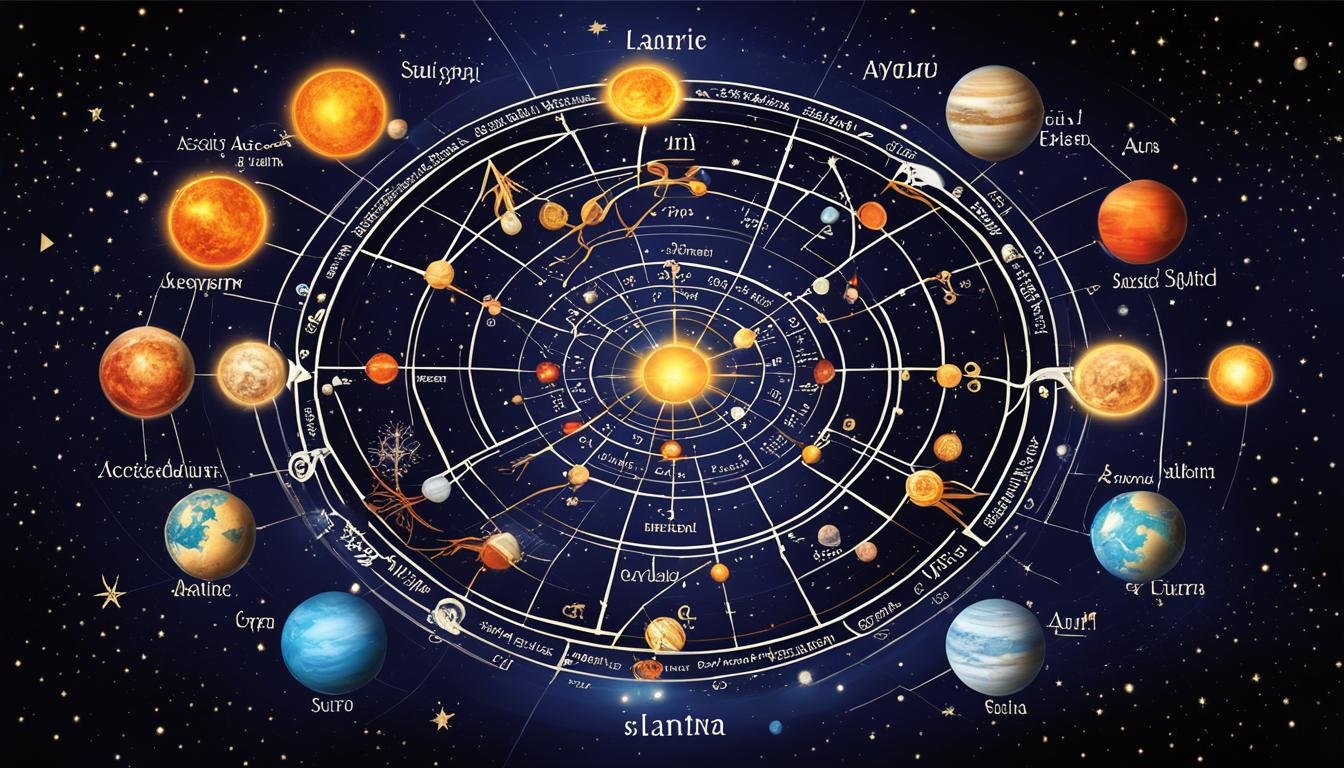How to Read a Vedic Astrology Chart?
Are you intrigued by the mysteries of Vedic astrology? Do you wish to decipher the secrets hidden within your birth chart? Understanding and interpreting a Vedic astrology chart may seem complex, but with the right guidance, you can unlock valuable insights into your life’s direction, purpose, and more.
A Vedic astrology chart, also known as a birth chart or horoscope, is a fascinating representation of the positions of the planets and their influence at the time of your birth. It consists of 12 houses that signify different aspects of your life, such as relationships, finances, and spirituality.
Decoding a Vedic astrology chart involves a deep analysis of the placement of these houses, the classification of the houses as good, bad, or neutral, and the exploration of various trinities that provide valuable insights into different areas of life.
Key Takeaways:
- Understanding a Vedic astrology chart allows you to gain valuable insights into various aspects of your life.
- Interpretation involves analyzing the 12 houses, their classification, and exploring trinities that represent different areas of life.
- Your birth chart can reveal your life’s purpose, financial prospects, and relationship dynamics.
- Approach the interpretation with patience, study, and an open mind to fully embrace the wisdom of Vedic astrology.
- Consulting with an experienced Vedic astrologer can provide further clarity and guidance on your chart analysis.
Identifying the 12 Houses in the Vedic Birth Chart
In Vedic astrology, the birth chart consists of 12 houses, each representing different aspects of life. These houses are identified by a rectangle divided into 12 sections, which are further divided based on the precise time and location of your birth. Understanding the placement of these houses is essential in interpreting the chart and gaining valuable insights into your life’s journey.
The 12 houses in Vedic astrology are named as follows:
- First House (Lagna): Represents the self, physical appearance, personality traits, and overall well-being.
- Second House (Dhana): Governs wealth, possessions, financial stability, and material resources.
- Third House (Sahaj): Signifies siblings, communication, short trips, courage, and mental abilities.
- Fourth House (Sukh): Associated with home, family, property, emotional well-being, and comfort in life.
- Fifth House (Putra): Pertains to creativity, intelligence, romance, children, and speculative activities.
- Sixth House (Shatru): Represents enemies, conflicts, diseases, debts, obstacles, and daily work routines.
- Seventh House (Bharya): Governs partnerships, marriage, relationships, business alliances, and legal matters.
- Eighth House (Mrityu): Associated with transformations, secrets, hidden wealth, longevity, and spiritual pursuits.
- Ninth House (Bhagya): Signifies higher education, spirituality, luck, long-distance travel, and philosophical beliefs.
- Tenth House (Karma): Governs career, professional achievements, public reputation, and social status.
- Eleventh House (Labh): Pertains to gains, income, social circles, friendships, and aspirations.
- Twelfth House (Vyaya): Represents losses, expenses, isolation, spiritual liberation, and dealing with the subconscious.
Each house plays a unique role in your life and provides valuable insights into various areas. They interact with the planets and other celestial bodies in your birth chart, influencing your experiences, opportunities, and challenges.
Now that you have identified the 12 houses in the Vedic birth chart, you can proceed to analyze their positions, connections, and classifications to gain a deeper understanding of your astrological profile.
To help you visualize the houses and their significance, here is an image of the Vedic birth chart:
Classifications of the Houses in Vedic Astrology
In Vedic astrology, the houses are classified into three categories: Kendra houses, Panapara houses, and Apoklima houses. Understanding these classifications is crucial when analyzing a Vedic astrology chart and assessing the strength and importance of the planets in different houses.
Kendra Houses
The Kendra houses are considered the most important and powerful houses in Vedic astrology. They are the 1st, 4th, 7th, and 10th houses in the birth chart. These houses represent the pillars of life and have a significant influence on an individual’s overall well-being, career, and relationships.
Panapara Houses
The Panapara houses are associated with wealth, material possessions, and comforts. They are the 2nd, 5th, 8th, and 11th houses in the birth chart. These houses indicate financial stability, creativity, and gains in various areas of life, including investments, speculation, and intellectual pursuits.
Apoklima Houses
The Apoklima houses are considered weakened and have relatively less power compared to the Kendra and Panapara houses. They are the 3rd, 6th, 9th, and 12th houses in the birth chart. These houses represent challenges, debts, losses, and spiritual growth. However, they also offer opportunities for personal growth and liberation.
By understanding the classifications of the houses in Vedic astrology, you can gain valuable insights into the different areas of life and how they are influenced by the planets in your birth chart. Now, let’s explore how these house classifications can further deepen your understanding of Vedic astrology chart analysis.

Exploring Financial Prospects in Vedic Astrology Chart
The Artha Trinity in Vedic astrology consists of the 2nd, 6th, and 10th houses, which hold valuable insights into your financial prospects and overall livelihood. These houses provide a deeper understanding of wealth accumulation, career success, and social standing in your life.
The 2nd House: Possessions and Financial Comfort
The 2nd house in Vedic astrology signifies material possessions, personal finances, and financial stability. It influences your ability to earn, save, and manage wealth. A strong 2nd house indicates financial security, while afflictions may indicate challenges in this area. By examining the planets and their aspects in the 2nd house, you can gain valuable insights into your financial potential and comfort.
The 6th House: Health and Nutrition
The 6th house in Vedic astrology is associated with health, well-being, and maintaining a balanced lifestyle. It represents your ability to overcome obstacles and handle challenges related to both physical and mental health. The 6th house also influences your approach to work and the steps you take to maintain financial stability. Analyzing the planets and their positions in this house can provide valuable insights into your overall health and its impact on your financial prospects.
The 10th House: Social Standing and Reputation
The 10th house in Vedic astrology represents your social standing, reputation, and career path. It governs your professional life, public image, and the level of success you can achieve. A strong 10th house indicates steady career growth and recognition, while afflictions may lead to challenges or delays in professional endeavors. By analyzing the planets and their influences in the 10th house, you can gain a deeper understanding of your career potential and financial growth.
To gain a comprehensive understanding of your financial prospects in Vedic astrology, it is crucial to analyze the placement, strength, and aspects of the planets in the 2nd, 6th, and 10th houses. This analysis can help you make informed decisions, set financial goals, and navigate towards a prosperous and fulfilling financial future.
Understanding Relationships in Vedic Astrology Chart
The Kama Trinity in Vedic astrology consists of the 3rd, 7th, and 11th houses, which are associated with relationships and desires. The 3rd house represents siblings and communication skills, the 7th house represents partnerships and marriage, and the 11th house represents income and friendships. Analyzing these houses can provide insights into an individual’s romantic future and various types of relationships.
3rd House – Siblings and Communication Skills
The 3rd house in Vedic astrology represents the bond with siblings, communication skills, and short-distance travel. It offers insights into your relationship with your brothers and sisters, as well as your communication style and ability to express yourself effectively. If there are favorable planetary influences on this house, you may have a close-knit relationship with your siblings and excel in areas such as writing, speaking, or teaching.
7th House – Partnerships and Marriage
The 7th house is known as the house of partnerships and marriage in Vedic astrology. It represents your long-term committed relationships, including marriage and business partnerships. Analyzing the 7th house can provide insights into the type of partner you may attract, the qualities you seek in a relationship, and how you approach marriage or committed partnerships. Favorable planetary placements in this house can indicate harmonious and fulfilling relationships.
11th House – Income and Friendships
The 11th house is associated with income, gains, and friendships in Vedic astrology. It reveals your social network, friendships, and the support you receive from others. This house also sheds light on your income sources, financial gains, and aspirations. Analyzing the 11th house can provide insights into your ability to attract wealth, maintain prosperous friendships, and achieve your financial goals.
Understanding the dynamics of the 3rd, 7th, and 11th houses in your Vedic astrology chart offers valuable insights into your romantic relationships, communication abilities, partnerships, and friendships. By examining the planetary influences on these houses, you can gain a deeper understanding of your relationship patterns and explore opportunities for personal growth and fulfillment.
Conclusion
Reading a Vedic astrology chart requires a deep understanding of the placement and classification of the 12 houses. By analyzing the houses, their lords, aspects, conjunctions, and planetary time periods, you can gain valuable insights into various aspects of your life.
The 12 houses in Vedic astrology represent different areas of life, such as relationships, financial prospects, and life’s purpose. Through careful analysis, you can uncover your true life’s direction, discover your purpose, and gain clarity on your financial potential.
It’s important to approach the interpretation of your Vedic astrology chart with patience, study, and an open mind. This ancient practice offers profound insights and guidance, but it requires dedication and a willingness to explore the depths of your birth chart. By embracing this process, you can unlock the wisdom and knowledge hidden within the cosmic energies, empowering yourself to make informed decisions and navigate life’s journey with confidence.
FAQ
How do I read a Vedic astrology chart?
To read a Vedic astrology chart, start by identifying the 12 houses, which are represented by a rectangle divided into 12 sections. Each house has its own significance and represents different aspects of life. It’s important to understand the classification of the houses as good, bad, or neutral, as this will determine the impact they have on your life.
What are the 12 houses in the Vedic birth chart?
The Vedic birth chart consists of 12 houses, each representing different aspects of life. These houses are identified by a rectangle divided into 12 sections. Understanding the placement of these houses is crucial in interpreting the chart. It’s important to know the boundaries and positions of each house, as well as their classification as good, bad, or neutral.
How are the houses classified in Vedic astrology?
The houses in Vedic astrology are classified into three categories: Kendra houses, Panapara houses, and Apoklima houses. Kendra houses are considered the most important and powerful, while Panapara houses are associated with wealth and material things. Apoklima houses are seen as weakened and have little power. Understanding these classifications helps in assessing the strength and importance of the planets located in different houses.
How can I discover my life’s purpose through a Vedic astrology chart?
The Dharma Trinity in Vedic astrology consists of the 1st, 5th, and 9th houses, which are associated with spiritual action and one’s purpose in life. The 1st house represents the self, the 5th house represents creativity and romance, and the 9th house represents higher learning and spirituality. Analyzing these houses can provide insights into the path and purpose of an individual’s life journey.
How can I explore my financial prospects through a Vedic astrology chart?
The Artha Trinity in Vedic astrology consists of the 2nd, 6th, and 10th houses, which are associated with wealth and financial wellbeing. The 2nd house represents possessions and financial comfort, the 6th house represents health and nutrition, and the 10th house represents social standing and reputation. Analyzing these houses can provide insights into an individual’s financial prospects and livelihood.
How can I understand my relationships through a Vedic astrology chart?
The Kama Trinity in Vedic astrology consists of the 3rd, 7th, and 11th houses, which are associated with relationships and desires. The 3rd house represents siblings and communication skills, the 7th house represents partnerships and marriage, and the 11th house represents income and friendships. Analyzing these houses can provide insights into an individual’s romantic future and various types of relationships.
What should I keep in mind when analyzing a Vedic astrology chart?
Reading a Vedic astrology chart requires understanding the placement of the 12 houses, the classification of the houses as good, bad, or neutral, and exploring the trinities that provide insights into different aspects of life. By analyzing the houses, their lords, aspects, conjunctions, and planetary time periods, one can gain a deeper understanding of their life’s direction, purpose, financial prospects, and relationships. It is important to approach the interpretation of a Vedic astrology chart with patience, study, and an open mind.







